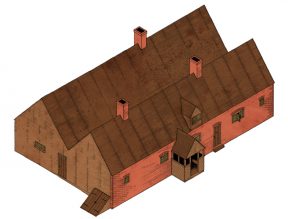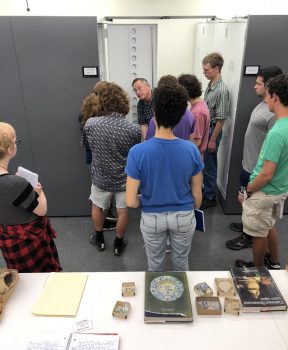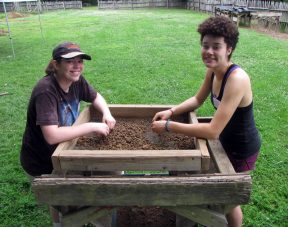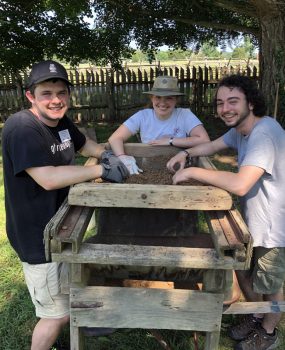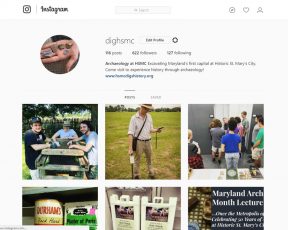Back to Dispatches from Field School
Field School 2018 – Week 1
Travis Parno — Chief Archaeologist
“The 2018 Field Season Begins!”
It’s hard to believe that another year has passed, but we’re thrilled to welcome ten students from colleges and universities around the country to learn the ins and outs of archaeology with us during the 2018 Field School in Historical Archaeology. This year’s field school will mark the tenth consecutive field season spent at the Leonard Calvert House, also called the Country’s House. For the 2018 season, we’ll be working in the property’s north yard searching for evidence of outbuildings.
First, a bit of background on the Calvert House site. It’s a fascinating property that includes the buried (and since partially reconstructed) remains of Leonard Calvert’s home. Construction of the building began in the mid-1630s. Originally, the home was probably a modest hall-and-parlor house with a central fireplace, but soon it was expanded to become one of the largest timber-frame houses in early Maryland.
The Calvert House was home to multiple residents following Leonard Calvert’s death in 1647, but by the early 1660s, it took on a new role as the Country’s House, so named because it was owned by the colony (or “Country”) and functioned as the first official statehouse of Maryland. Because it wasn’t needed as a governmental meeting space year-round, the building was leased as an “ordinary” or inn, and thus doubled as a place where visitors and travelers could rest and enjoy a warm meal.
After the construction of the new brick statehouse in 1676, the colony’s official use of the Calvert (or Country’s) House declined. Documentary records tell us that by the end of the 17th century, the structure was sorely in need of repairs and, following the move of Maryland’s capital to what would become Annapolis, it fell into disuse. In 1841, Dr. John Brome built a large plantation house over the buried foundations of the Calvert House and Dr. Brome, his family, and their servants and slaves lived on the property for many years. Dr. Brome’s house was moved down to Rosecroft Road in 1994 and now functions as an inn. A surviving duplex slave quarter from the Brome family era was also relocated and recently reopened as an exhibit documenting the lives of Africans and African Americans in St. Mary’s County in the 19th and 20th centuries.
While the previous season of fieldwork explored unexcavated areas immediately adjacent to the Calvert House’s foundation, this season will see a move back into the north yard of the property where a large cluster of postholes was discovered over the course of several seasons. Our primary goal for the season is to excavate in this area to determine if any of these postholes were part of a discrete feature, i.e., an outbuilding of some sort. The Calvert House enjoyed a long and storied life, and history tells us that any property of such size and importance would have featured outbuildings to support the varied functions the building served. Such outbuildings may have included dairies, barns, storehouses, and/or auxiliary food preparation spaces. We have not yet been able to sort a building out of the constellation of postholes in our target area, but we are hopeful that this summer’s work may yield more information. We are particularly intrigued by one very large posthole that was found during the 2016 season. A posthole of this size is more likely to have been part of a structure rather than part of a fence or other, less robust landscape feature.
But before our students could put shovels and trowels to the soil, they needed to first learn about the history of St. Mary’s City, as well as some of the fundamentals of excavation methods and archaeological artifact identification.
Our team spent their first day hearing about the history of historical and archaeological research at Historic St. Mary’s City, before heading out onto the landscape for a tour of our many interpretive sites. For the next two days, the students learned about 17th– and 18th-century ceramics, examining examples of some of the many types of pottery that we find on our sites. They also received foundational instruction in the basics of archaeological field methods. As we always teach, archaeologists typically collect the same types of data, but each institution has its own specific manner of collecting that data. The HSMC way requires meticulous attention to detail and exhaustive documentation. We’re very much aware of our responsibility to the citizens of Maryland, and the entire United States, as we excavate the remains of the state’s first capital in this National Historic Landmark.
On day four of our first week, we ventured out to the Calvert House site to begin our fieldwork! Much like their time in the laboratory, the students reviewed some necessary information before diving into the excavation process. They learned our basic site policies, toured the excavation trailer, became familiar with the various tools they would use on-site each day, and practiced setting up our pop-up tents.
Once the introductory steps were completed, we began our fieldwork. We targeted three 5′×10′ areas, two of which were located on top of where a gravel driveway used to cut across the property to provide an approach to the Brome-Howard House.
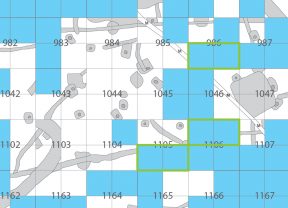
Site map showing target areas for the 2018 field season (outlined in green). The gray shapes with dark gray circles inside of them are post holes found in vicinity. Blue areas have not yet been excavated
Thanks to members of our maintenance staff, sections of the gravel driveway had been carefully graded away with a mechanical excavator prior to our team’s arrival on the site. There are still plenty of gravelly soils to work through, but the excavator eased what could have been a very slow and painful process.
Most of day four and five were spent excavating through what topsoil and gravel driveway fill remained in each of our three target areas. This offered students the opportunity to become familiar with using trowels and shovels, while also affording them the chance to examine lots of gravel in in the screen in search of archaeological artifacts.
Most of the suspected finds turned out to be rocks, but the team did discover an assortment of typical historical artifacts: fragments of brick and oyster shell, iron nails, and a couple of small pieces of clay tobacco pipes.
We hope that these few remnants will whet the students’ appetites for what will surely be a productive and fun summer filled with lots of fascinating finds!
As we continue our work over the next nine weeks of the program, continue checking our website, Facebook page, and Instagram feed (@digHSMC) for more coverage of the field school’s progress. In the coming weeks, you’ll hear first-hand from our students as they describe their experiences excavating the history of Maryland’s first capital. We can’t wait to see what they find…


